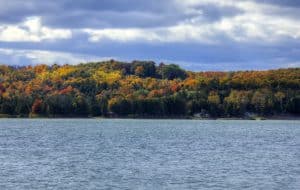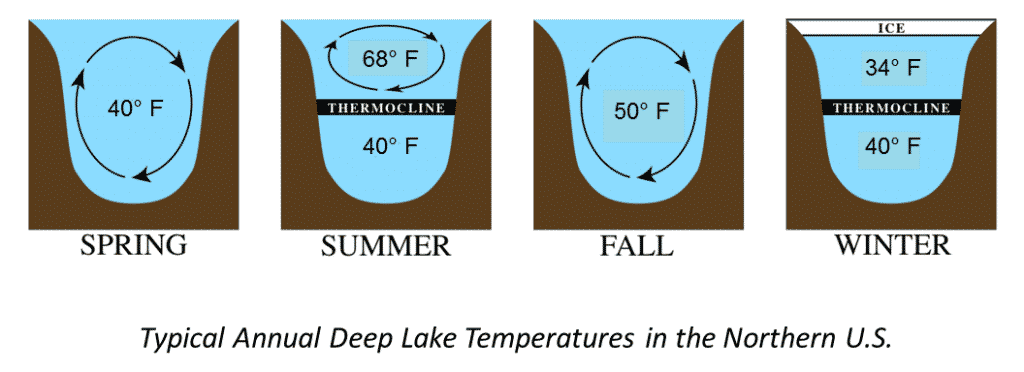DISCLOSURE: This post may contain affiliate links, meaning when you click the links and make a purchase, I receive a commission. As an Amazon Associate I earn from qualifying purchases.
 Fall crappie fishing can often times be very frustrating for anglers. Crappie are often found in what seem to be random places. In spring, crappie move to the shallows to spawn. In summer, they tend to suspend off the bottom in the thermocline (aka a layer of comfortable temps and oxygen), but where do they go in the fall?
Fall crappie fishing can often times be very frustrating for anglers. Crappie are often found in what seem to be random places. In spring, crappie move to the shallows to spawn. In summer, they tend to suspend off the bottom in the thermocline (aka a layer of comfortable temps and oxygen), but where do they go in the fall?
The Turnover
As the fall brings colder temperatures, the surface of the body of water begins to cool. Because cold water becomes more dense and heavier than warm water, it begins to sink. However, as water gets below about 40°F it starts to rise again due to becoming less dense. This up and down movement of water causes turnover, or “mixing” of a lake. This will last for a few days or weeks, depending on the size of the body of water. After this, the water will become pretty close to the same temperature and oxygen level throughout the various depths.

Not all bodies of water will turnover, especially shallower ones or constantly moving bodies like flowages and rivers. Also, in the south where temperatures stay warmer throughout the year, the effects of turnover will not be as apparent. Therefore, you may not have to change your tactics too much from the summer months. Remember also that with larger and deeper lakes, turnover will take longer to begin. In this case, you may want to stick to summer tactics and fish for suspended crappie in deeper water until around October.
Crappie do not like this churning of the water and constant changing of temperatures. Like us, they like to be comfortable and it’s hard to do so when your environment is always changing. This is essentially what makes fall crappie fishing so difficult. Crappie are constantly moving trying to find a comfortable spot and can often be scattered around a lake.
Where to Look
Early in the fall (September timeframe) when the water is turning over you should look for spots that will remain comfortable for crappie. First, go to the bays. These areas may not have been as affected by turnover due to their shallower depths and protection from wind. If you can fish a narrow mouth to a small bay you will be off to a great start. This can provide the right amount of protection and comfort that crappie are sure to be looking for. Inlets from other lakes or rivers can also be gems due to the incoming flow of oxygen rich water. Try fishing in the shallows on windward shores, edges of weed beds, rock piles, submerged trees, and docks as well.
Later in the fall, most lakes will have constant temperature and oxygen levels throughout. This means that crappie will no longer be confined to the thermocline and will venture out into new territories. At the same time, the colder temperatures will cause shallow weeds to begin to die and give off gases from their decomposition. Baitfish, and therefore bigger fish, do not like this and will move further out to deeper water. So if crappie aren’t suspended in deeper water, but are also not in the shallows, where do you look? Deep weed growth. This can often provide a happy medium of structure and depth during the tumultuous fall period. Try moving further out from shallow weed beds until you encounter a steep drop off. Contour maps (also called bathymetric maps) of the lake and depth finders can be very helpful in this situation. I use Fishidy to get high quality contour maps.

If this still doesn’t provide any luck, try spider trolling. This is an easy way to cover a lot of water to find exactly where the crappie are hiding.
What to Use
Like usual, small jigs and minnows can be very effective. During this period, crappie’s metabolisms begin to slow and they will consequently move slower than in the summer months. Remember this when jigging or retrieving. Let it drop a little, and reel in slow. Give every chance you can to the fish to strike.
Stump bumping may bring out those finicky crappie during fall, too. It’s a good way to search next to a piece of structure while simultaneously searching different depths.
During and after turnover, the water may get murky. This is due to the up-churning of all the dead plant matter and debris on the bottom of the lake. If you notice this happening, make your presentation bright, loud, and smelly. For example, a bright chartreuse jig on a safety-pin spinner tipped with a piece of minnow would satisfy all three conditions.
It will take a little more patience to find the fish during the fall. This is expected. Bay mouths, inlets, and other “comfort zones” can be safe retreats for crappie during fall turnover. In late fall deep weed beds may be the key to your success. Whip out the contour maps and depth finders and spider troll until you find the perfect spot and you just may develop a whole new outlook on fall crappie fishing!